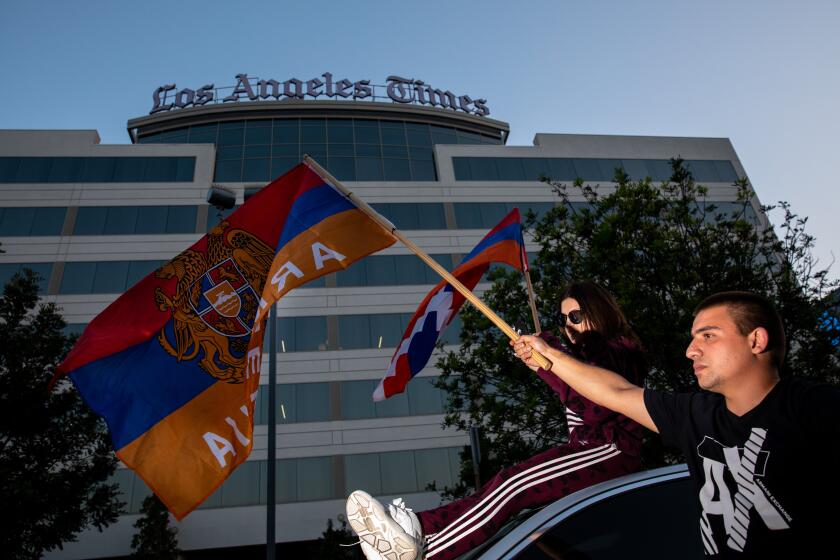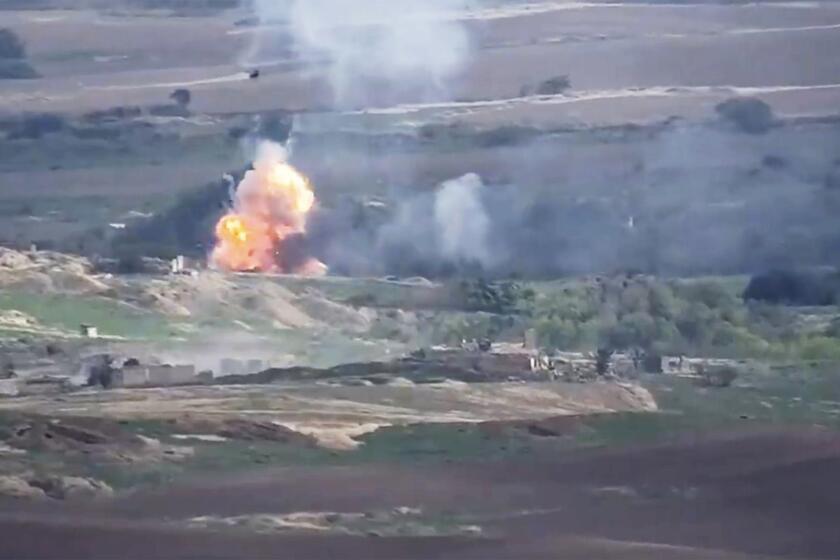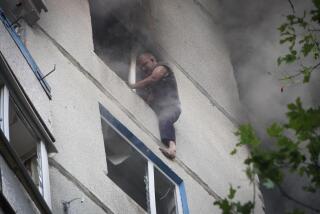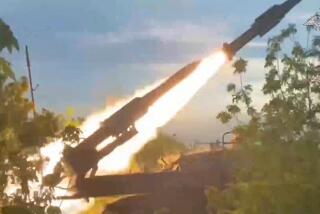‘How long will it last?’ Civilians tremble amid fighting in Nagorno-Karabakh
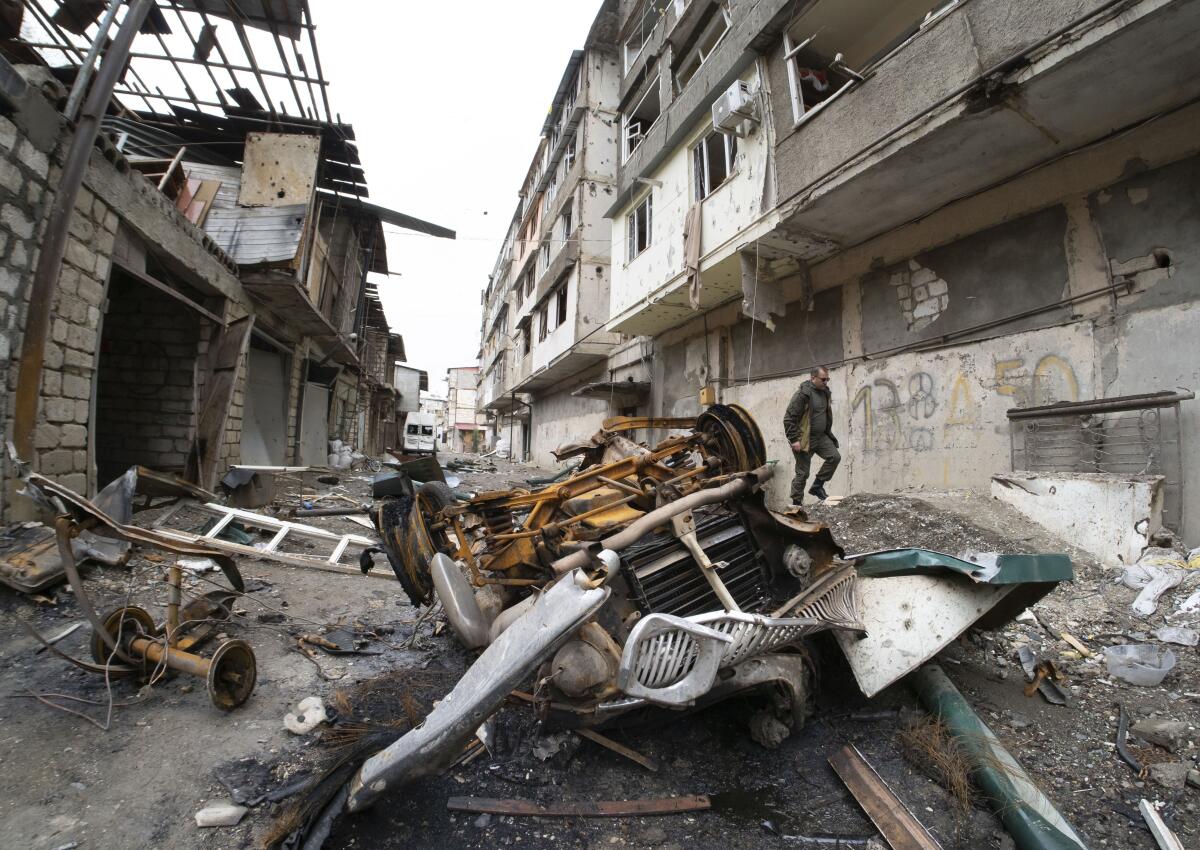
YEREVAN, Armenia — The intense shelling in the separatist region of Nagorno-Karabakh is taking its toll on the civilian population as fighting between Armenian and Azerbaijani forces showed no signs of abating Wednesday, with one resident hunkered down in a shelter overnight asking in despair: “How can one stand it? How long will it last?”
Clashes between Azerbaijani and Armenian forces in the region since Sept. 27 have killed hundreds in the worst escalation of hostilities since 1994, when a truce ended a war that raged for several years. Nagorno-Karabakh lies inside Azerbaijan and is internationally recognized as belonging to Azerbaijan, but for more than a quarter-century has been under the control of ethnic Armenian forces backed by Armenia.
Stepanakert, the territory’s capital, has been under intense attack in recent days. Footage by the Associated Press showed flashes of explosions that could be seen from the city center Tuesday night.
Local residents, distraught over continued strikes on the city, have been gathering in shelters to escape the violence.
“Buildings and houses are destroyed. We are so afraid of it,” a woman named Sida, who declined to give her surname, said of the bombing. “How can one stand it? How long will it last?”
Armenian Defense Ministry spokesman Artsrun Ovannisian said Wednesday that Stepanakert was being targeted once again by Azerbaijan along with other settlements. Nagorno-Karabakh officials said that non-military facilities in Stepanakert have been hit by missiles and drones.
The protesters shut down Imperial Highway and Douglas Street about 6 p.m. Tuesday, with some chanting, “Shame on the L.A. Times.”
The Russian state news agency RIA Novosti reported Wednesday that some of the overnight shelling had hit people’s houses, causing significant damage.
Azerbaijan has rejected claims that it targeted civilian infrastructure in Stepanakert. Hikmet Hajiyev, an aide to Azerbaijani President Ilham Aliyev, said in an interview earlier this week that Azerbaijani forces struck only at military targets in and around Stepanakert. But he acknowledged that “some collateral damage” was possible.
The fighting in the region — involving heavy artillery, warplanes and drones — has continued despite numerous international calls for a cease-fire. Both sides have accused each other of expanding the hostilities beyond Nagorno-Karabakh and of targeting civilians.
The European Union expressed concern Wednesday about the flare-up of violence.
As Armenia-Azerbaijan fighting intensifies over separatist region, wider rivalries could come into play
“We have seen extremely worrying reports of attacks on populated areas, which is taking a deadly toll on civilians. We strongly urge the sides to fully observe their international obligations to protect civilian populations,” EU foreign policy chief Josep Borrell told members of the European Parliament.
Borrell said the Organization for Security and Cooperation in Europe, or OSCE, has no observers on the ground, and so the EU cannot rely on much of the information being spread about the conflict.
“What we observe is an increasing amount of disinformation which is aimed at mobilizing domestic audiences in both countries and could be used to pull regional actors into the conflict,” he said. “Media reports need therefore to be examined with great precaution.”
Borrell said that he had discussed the conflict with the foreign ministers of Armenia and Azerbaijan, and with those of Russia and Turkey, the main regional players closest to the conflict. Turkey has publicly backed Azerbaijan and said it was ready to provide military assistance, should Azerbaijan request it. Accusations have already surfaced of Turkish recruitment of Syrian mercenaries to fight in Nagorno-Karabakh and of Turkish warplanes being involved.
Breaking News
Get breaking news, investigations, analysis and more signature journalism from the Los Angeles Times in your inbox.
You may occasionally receive promotional content from the Los Angeles Times.
Russia is Armenia’s main ally and sponsor, and has a military base in the country. It also co-chairs the Minsk Group, set up to mediate the conflict under the auspices of the OSCE. Moscow has repeatedly called for a cease-fire and peace talks.
“It is important that regional actors refrain from any activity or rhetoric that could inflame things even further,” Borrell said.
“My last talk with the Azerbaijan [foreign] minister was also very much worrisome because he was clearly saying that the fight will continue until Armenia will accept a concrete schedule for withdrawing from Nagorno-Karabakh which is a precondition for talks,” Borrell said. “Things are getting worse.”
More to Read
Sign up for Essential California
The most important California stories and recommendations in your inbox every morning.
You may occasionally receive promotional content from the Los Angeles Times.
